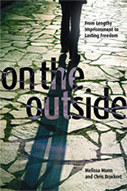On the Outside: From Lengthy Imprisonment to Lasting Freedom

Authors: Melissa Munn and Chris Bruckert
Publisher: Vancouver, BC: UBC Press, 2013. 240p.
Reviewer: Voula Marinos | March 2014
The authors are committed to revealing the stories of 20 inmates who had spent ten years or more in prison and were then charge-free for five or more – prolonged prisoners or ‘lifers.’ The men’s experiences of being released from prison are paralleled with the metaphorical rabbit hole. The authors begin with the theme of Alice in Wonderland, an appropriate metaphor for inmates who are halfway in or halfway out of the hole – easily back in if parole is violated and revoked. The book fills a gap in the Canadian correctional literature on how inmates successfully ‘make it,’ defined by the inmates themselves, including their challenges, struggles, strengths, successes, and the structural constraints of a system focused, at its core, on recidivism. The authors are focused, however, on a wider tale of the resettlement process (borrowing literature from migration studies) of a relatively heterogeneous group of prisoners in Canada.
The book is set within a unique and refreshing mix of theoretical lenses including: social-psychological, sociological, immigration settlement, critical human geographic theory, symbolic interactionist and post-modern literature. Canadian conservative federal policies such as the Safe Streets and Communities Act and the Corrections and Conditional Release Act set the political context for understanding the processes and perceived limitations by many of the men. The words of inmates are related to classic texts by Goffman, Cooley, Cohen and Foucault. More broadly, these multiple lenses provide the reader with an understanding of the multiple and complex layers of life on the ‘outside’ from men previously on the ‘inside.’
The words of the men are, at times, deeply emotional, graphic, raw and conflicting. At other times, I read the men’s words thinking about the simple tasks we take for granted, such as walking outside in the dark, or being comfortable having a drink and making regular conversation with a co-worker. For these men, these simple parts of life on the outside are what they had to learn after being released — and are revealed to the reader as being anything but simple.
The authors explore how factors such as gender, class, race, age, disability, health, sexuality, and geography affect the experiences of these men on the continuum of release from day passes to full parole. One of the most poignant themes used by the authors is geography. The authors explore how physical, psychological and emotional location and geography have a profound impact on the identity of these men, and how they wrestle with deep feelings of guilt, shame, stigma-management, confusion, vulnerability. These illustrate the difficulties in trying to settle in a life of belonging – not only in terms of residence, but belonging to a society. The men describe themselves as ‘normal’ or ‘average’ guys on parole, wanting ‘normalcy,’ dictated by white, male, middle-class standards of finding work, owning property, and getting married. However, the men’s experiences illustrate the challenges of accomplishing these goals when these standards have changed dramatically over the ten to twenty years of their youth that they have missed while in prison. At the same time, many of the men explained how individual officials such as psychologists, correctional officers or shop bosses supported their release — positive elements of a much-criticized system.
Equally unique is the authors’ prologue, written personally, relating to the profound impact these men have had on their own outlook as academics researching corrections, and the practical value that their research has had; namely being converted to a handbook for those on release and for lifers’ groups. Finally the methodology appendix is a wonderful asset for any student or researcher interested in the detailed and meticulous nature of qualitative research, showing how the interviews were carefully coded by theme using the popular N-vivo software. At times the reader would have benefited from further information about links to policy as part of a deeper understanding of the intricacies of release. That said, On the Outside is a welcome and refreshing academic book about the deeply profound impact of imprisonment and settlement on the outside.
Voula Marinos, Ph.D, Brock University, St. Catharines, Ontario


